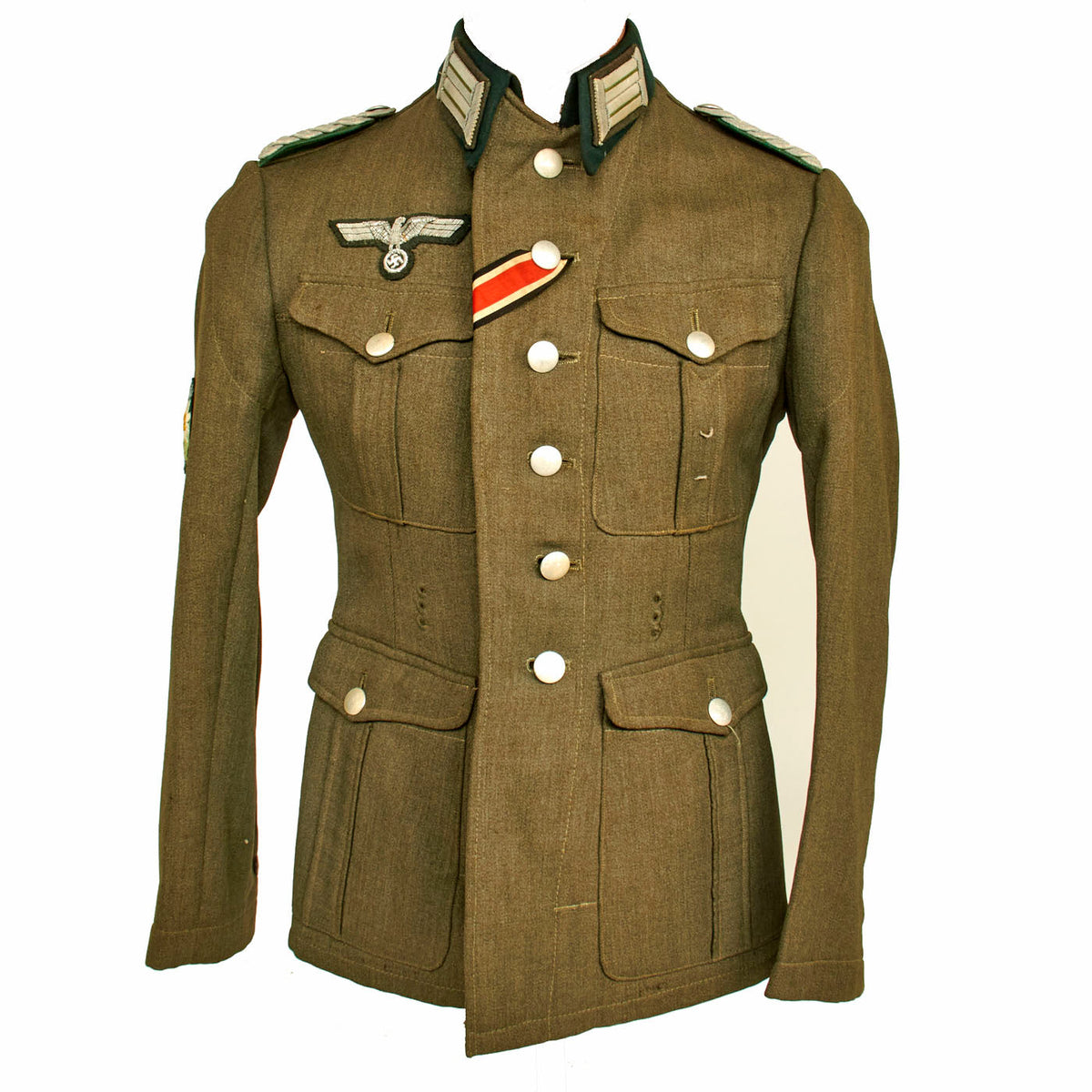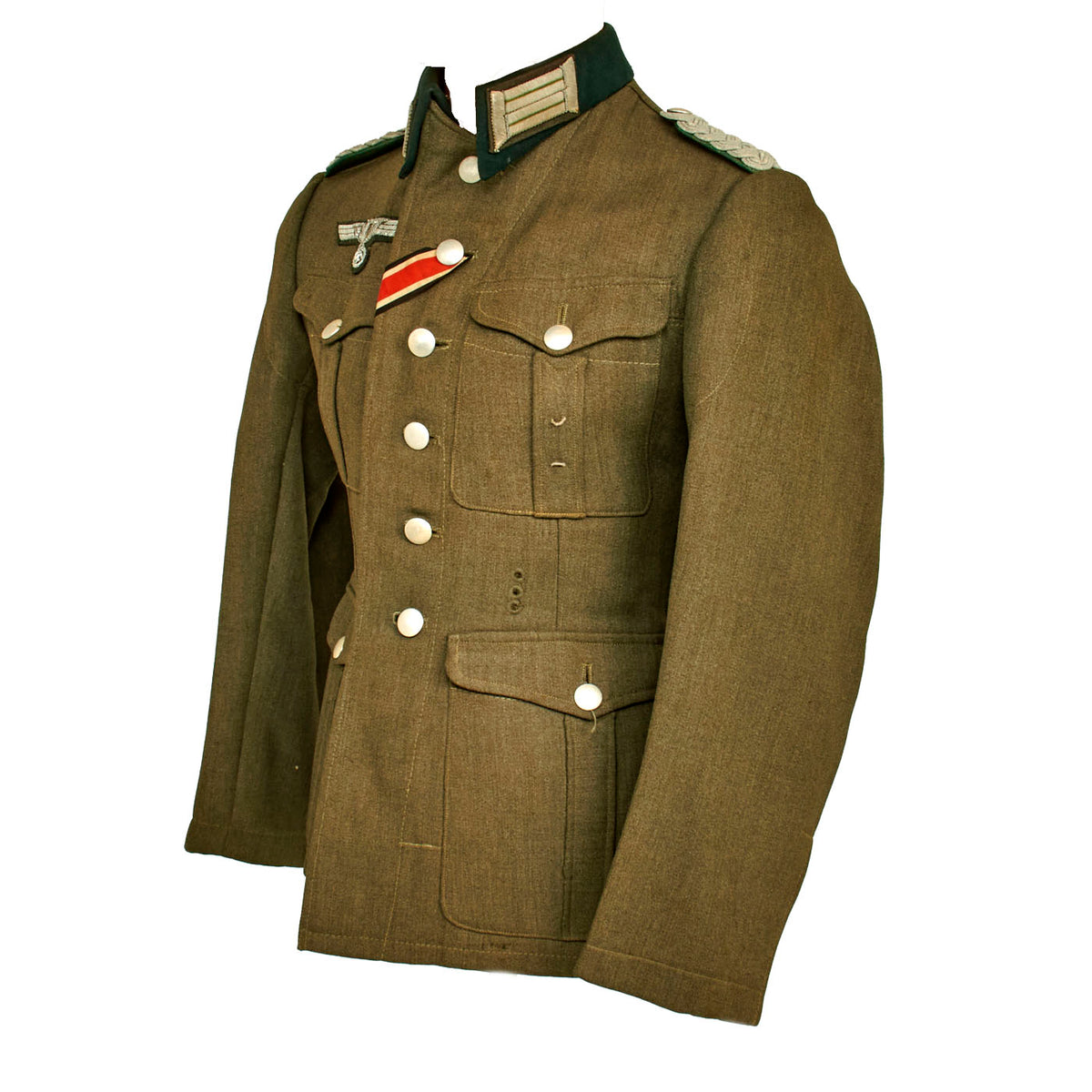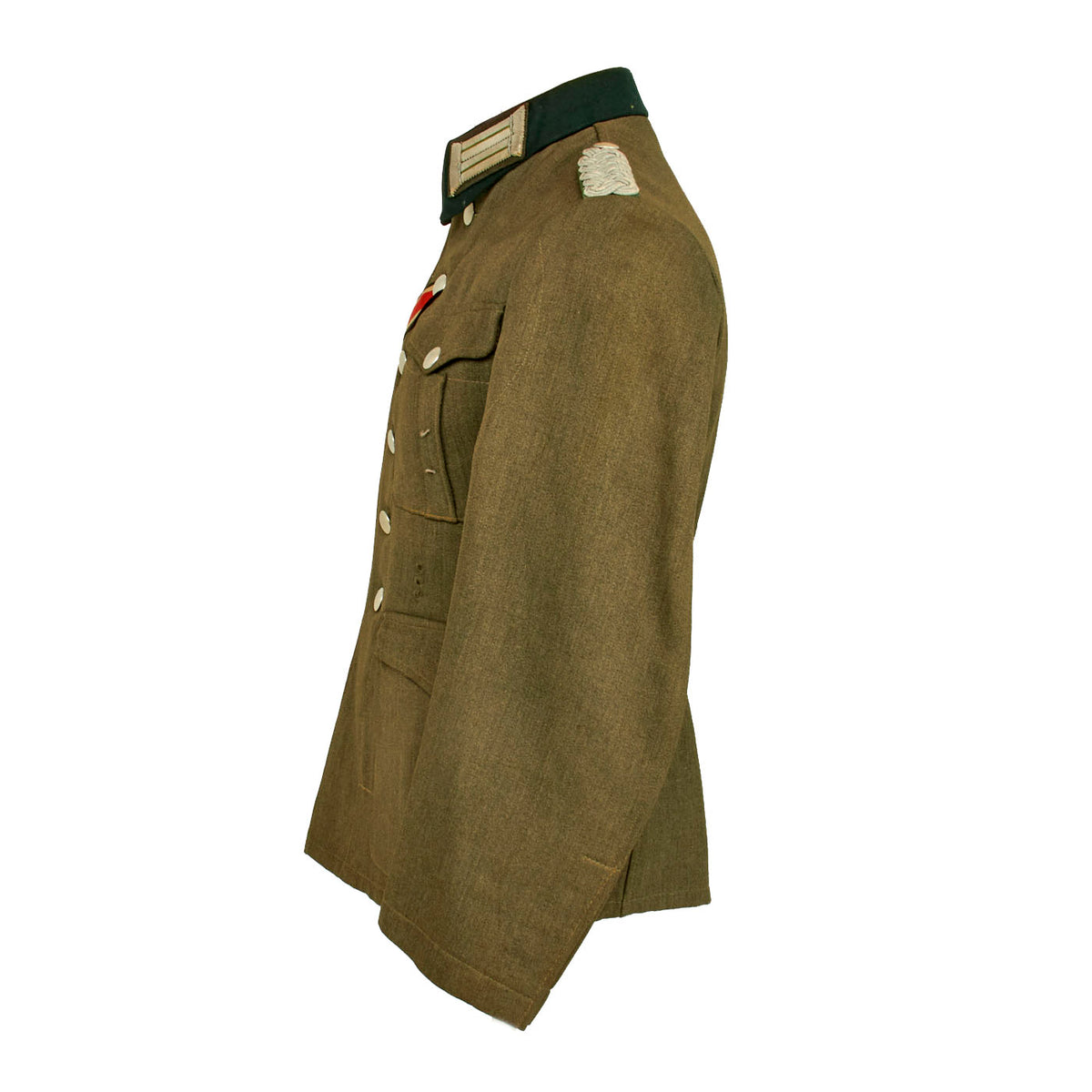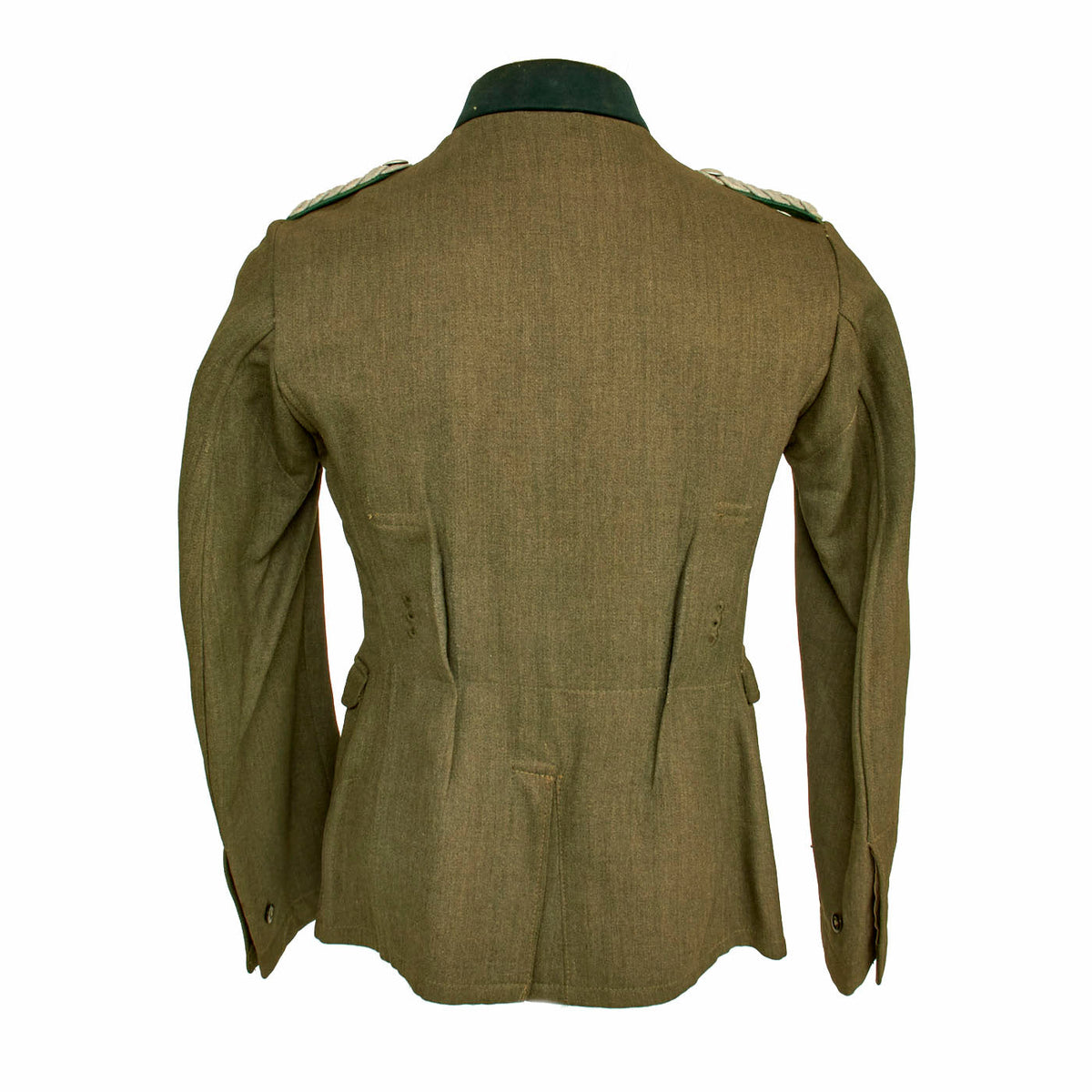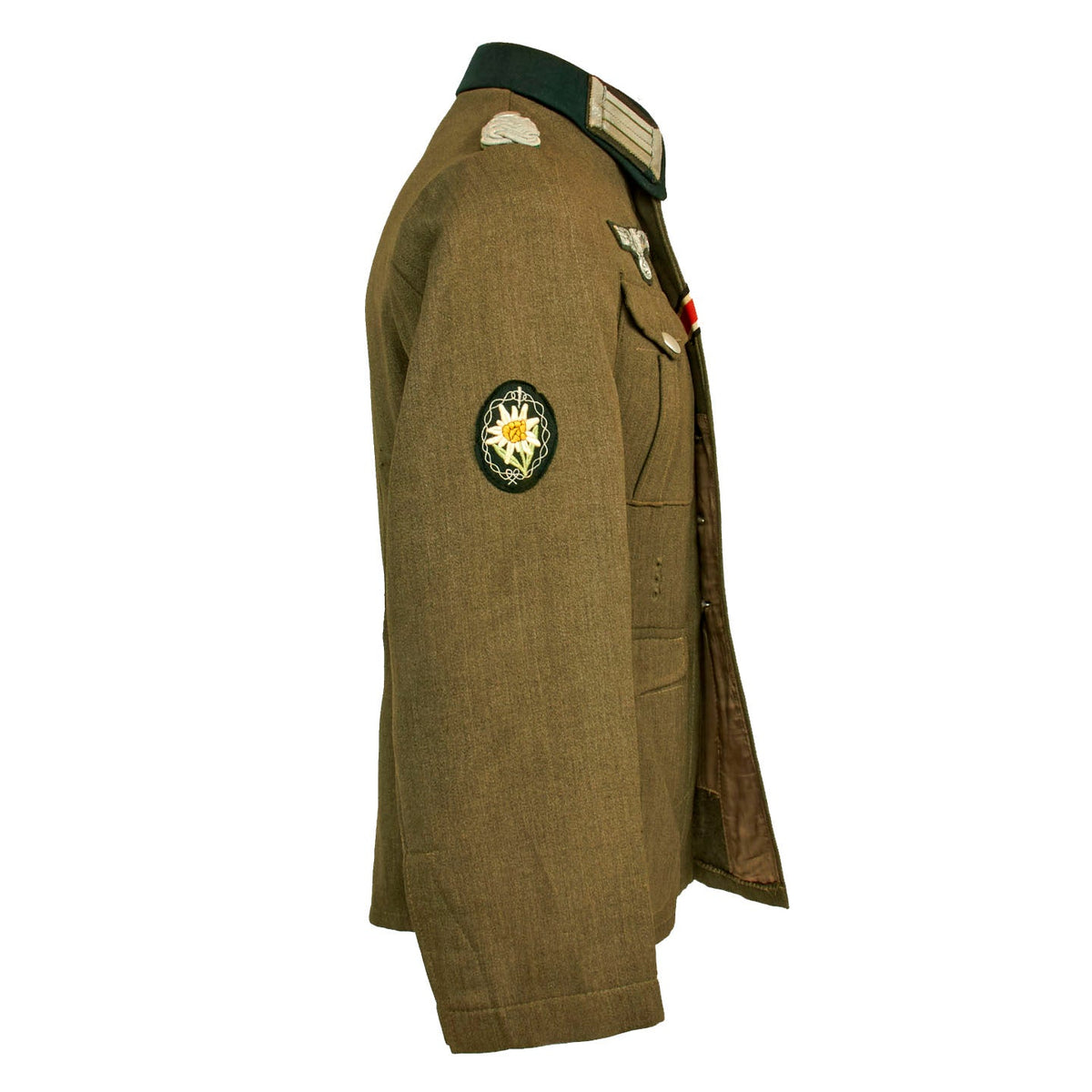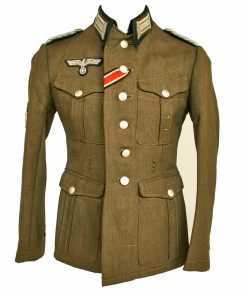Original German WWII Heer Army Mountain Troops Lieutenant M-36 Tailor Made Tunic – Gebirgsjäger Original Items
$ 1.795,00 $ 448,75
Original Item: Only One Available. This is a very nice, slightly worn untouched tunic. It still bears the original RBNr maker code and size stamps on the inside. The tunic features four pockets with scalloped flaps and pebbled aluminum buttons, silver wire shoulder boards on green wool, both in very good condition. The attractive Army breast eagle is hand embroidered in aluminum bullion, and is very neatly hand stitched to the chest in a fashion typical of wartime German tailor work, unfortunately some of the silver thread has worn away and oxidation is present. The collar tabs are green piped, and are machine applied; there is no sign of previous tabs ever having been applied.
The shoulders are adorned with boards, constructed of a cardboard-reinforced dark green wool base, with a layer of white piping, interwoven silver and green bullion strands in the Russian braid style in an interlocking weave pattern. The boards are secured to the tunic at the outer edge by stitching and at the inner edge by a pebbled, silvered, non-magnetic metal button.
The tunic is closed with eight pebbled, silvered, magnetic metal buttons on the right breast flap meeting an equal number of reinforced buttonholes on the left flap. All buttons are maker marked on the reverse.
The left shoulder features a Heer Officer Gebirgsjäger Sleeve Badge – Edelweiss. The badge is machine embroidered on a greenfelt backing. There are minor moth nips on the edges but it is in lovely overall condition.
This is truly a lovely untouched example in great condition. Comes ready to display.
Measurements:
Collar to shoulder: 9”
Shoulder to sleeve: 23”
Shoulder to shoulder: 16.5”
Chest width: 16.5”
Waist width: 15.5”
Hip width: 18”
Front length: 27.5″
Terms such as M40 and M43 were never designated by the Wehrmacht, but are names given to the different versions of the Model 1936 field tunic by modern collectors, to discern between variations, as the M36 was steadily simplified and tweaked due to production time problems and combat experience.
Field Tunic (Feldbluse) Model 1936
When the NSDAP came to power in early 1933 the Reichswehr, the armed forces of the Weimar Republic, were near the end of a two-year project to redesign the Army Feldbluse (field-blouse). Beginning in that year the new tunic was issued to the Reichsheer and then the rapidly growing Wehrmacht Heer, although minor design changes continued to be made until the appearance of the standardized Heeres Dienstanzug Modell 1936. The M36 tunic still retained the traditional Imperial and Reichswehr uniform color of grey-green “field gray” (feldgrau) wool, but incorporated four front patch pockets with scalloped flaps and pleats (on Reichswehr tunics the lower pockets were internal and angled). The front was closed with five buttons rather than the previous eight, and the collar and shoulder straps were of a dark bottle-green instead of the Reichswehr grey. Compared to the Weimar-era uniforms the skirt of the feldbluse was shorter and the tailoring was more form-fitting due to Germany’s adoption of mechanized warfare: soldiers now spent much time in the confined space of a vehicle and a shorter jacket was less likely to pick up dirt from the seats. It also included an internal suspension system, whereby a soldier could hang an equipment belt on a series of hooks outside of the tunic. These hooks were connected to two straps inside the lining, which spread the weight of equipment without having to use external equipment suspenders. The M36 was produced and issued until the very end of the war, though successive patterns became predominant.
SS field uniforms were of similar appearance externally but to fit their larger patches had a wider, feldgrau collar, and the lower pockets were of an angled slash type similar to the black or grey SS service-dress. The second button of an SS Feldbluse was positioned somewhat lower, so that it could be worn open-collar with a necktie. Due to supply problems the SS were often issued army uniforms.
Fast Shipping with Professional Packaging
Thanks to our longstanding association with UPS FedEx DHL, and other major international carriers, we are able to provide a range of shipping options. Our warehouse staff is expertly trained and will wrap your products according to our exact and precise specifications. Prior to shipping, your goods will be thoroughly examined and securely secured. We ship to thousands clients each day across multiple countries. This shows how we're dedicated to be the largest retailer on the internet. Warehouses and distribution centres can be located throughout Europe as well as the USA.
Note: Orders with more than one item will be assigned a processing date depending on the item.
Before shipping before shipping, we'll conduct a thorough inspection of the items you have ordered. Today, the majority of orders will be delivered within 48 hours. The delivery time will be between 3-7 days.
Returns
The stock is dynamic and we cannot completely manage it because multiple stakeholders are involved, including our factory and warehouse. So the actual stock may alter at any time. It's possible that you may not receive your order once the order has been made.
Our policy is valid for a period of 30 days. If you don't receive the product within 30 days, we are not able to issue a refund or an exchange.
You can only return an item if it is unused and in the same state as the day you received it. You must have the item in its original packaging.
Related products
Uncategorized
Uncategorized
Uncategorized
Armored Burgonet Helmet & Polearm from Scottish Castle Leith Hall Circa 1700 Original Items
Uncategorized
Band of Brothers ORIGINAL GERMAN WWII Le. F.H. 18 10.5cm ARTILLERY PIECE Original Items
Uncategorized
Uncategorized
Uncategorized
Uncategorized
Angolan Rebel 1970s era 60mm Inert Display Mortar from Angolan Civil War Original Items
Uncategorized
Uncategorized
Uncategorized
Australian WWII Owen MK1 Machine Carbine SMG Custom Fabricated Replica with Sling Original Items
Uncategorized
Armoured Fighting Vehicles of the World: AFVs of World War One (Hardcover Book) New Made Items
Uncategorized
Uncategorized
Uncategorized
Uncategorized
Uncategorized
Uncategorized
